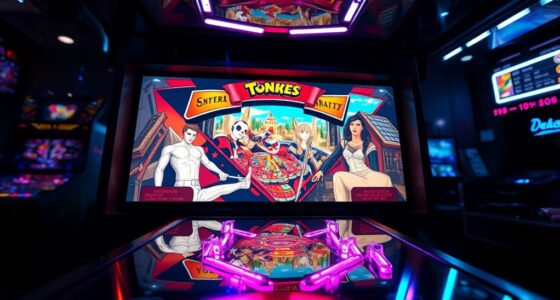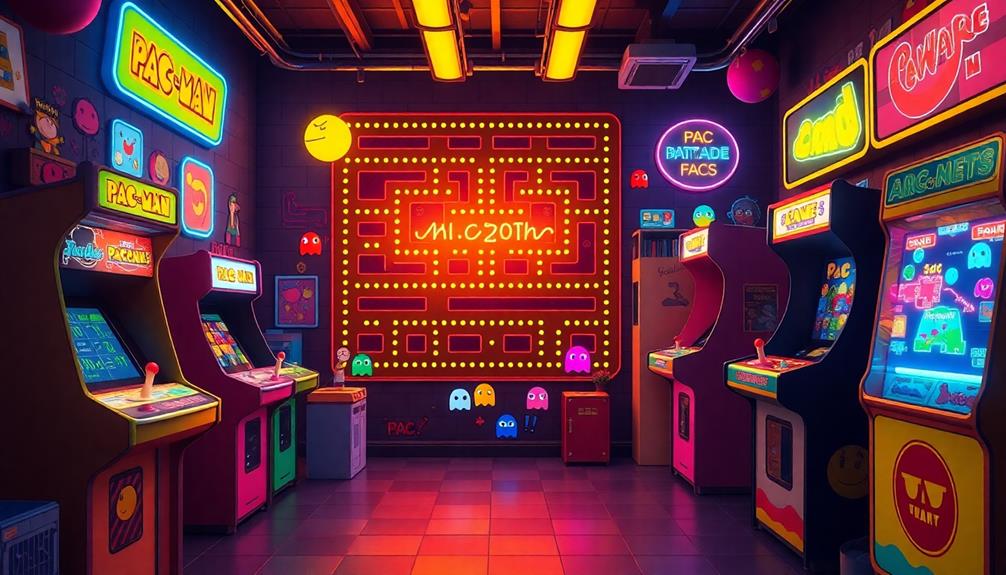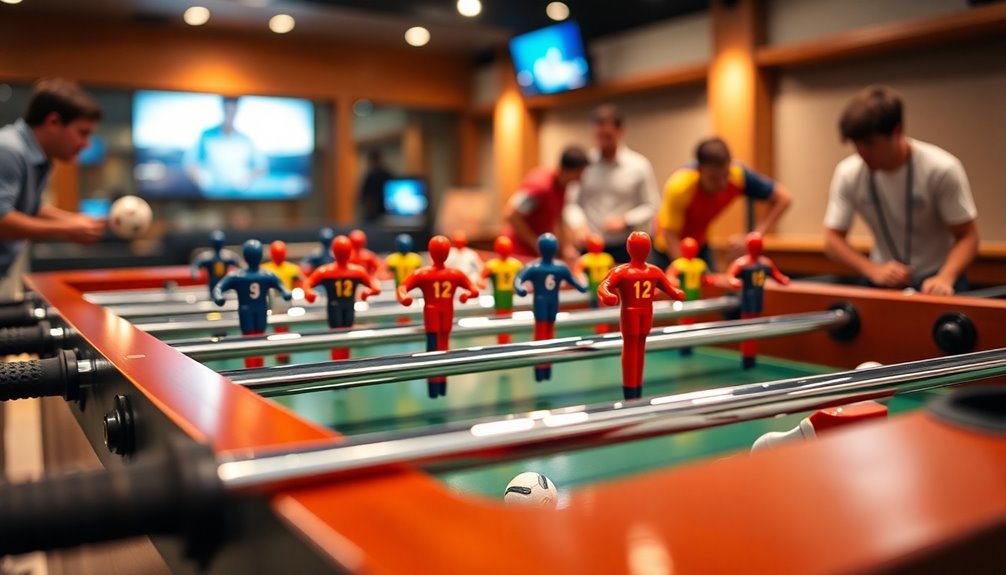To craft engaging pinball gameplay, focus on designing distinct modes that set clear goals and storytelling elements, keeping players motivated and immersed. Incorporate multiball to add excitement, challenge, and strategic depth with dynamic cues and rewards. Use visual and audio signals to signal shifts seamlessly, creating emotional peaks and maintaining flow. Balancing these elements and exploring innovations will help you develop dynamic, emotionally resonant experiences—if you keep exploring, you’ll uncover even more insights.
Key Takeaways
- Modes introduce narrative-driven objectives that enhance engagement and provide clear goals for players.
- Multiball boosts excitement, unpredictability, and scoring opportunities through synchronized visual and audio cues.
- Seamless hardware integration ensures smooth ball flow and clear signaling during mode transitions and multiball phases.
- Effective cues—visual, auditory, and tactile—guide players through objectives, transitions, and reward recognition.
- Balancing risk and reward in mode and multiball design creates strategic depth and maintains player immersion.
Defining Modes in Pinball Gameplay

In pinball gameplay, modes are distinct objectives or challenges that activate when certain targets or switches are hit, adding variety and depth to the game. These modes serve as narrative development tools, immersing you in a story or theme that unfolds as you progress. They influence player psychology by creating a sense of achievement and urgency, encouraging you to focus on specific tasks. As you complete objectives within a mode, the game’s story advances, making each session more engaging. Modes break the game into manageable segments, providing clear goals and motivation. This structure keeps your interest high and rewards your skillful play, making every game feel like a unique experience driven by evolving challenges and a compelling narrative arc. Additionally, understanding game design principles can help players appreciate how modes enhance overall gameplay engagement.
The Role of Multiball in Game Dynamics

Multiball keeps you engaged by adding excitement and unpredictability to the game. It also speeds up gameplay, challenging you to make quick decisions under pressure. Plus, it creates strategic moments where you can plan your moves to maximize scoring opportunities. Incorporating top-tier information and expert insights helps designers craft engaging multiball experiences that enhance overall game quality.
Enhancing Player Engagement
Introducing multiple balls into gameplay instantly ramps up excitement and keeps you engaged. Multiball creates a heightened sense of urgency, encouraging quick reactions and strategic thinking. To maximize engagement, combine adaptive sound effects that respond to the chaos, reinforcing the thrill with dynamic audio cues. Tactile feedback, like vibrations or button presses, immerses you further, making every hit and bounce feel more real. These sensory enhancements deepen your connection to the game, making multiball not just a visual spectacle but an interactive experience. By leveraging adaptive sound and tactile feedback, you stay focused and energized, transforming multiball from mere chaos into an enthralling challenge that heightens your overall enjoyment. Additionally, understanding the importance of contrast ratio can improve visual clarity during fast-paced moments, ensuring every detail is sharp and vivid. This approach keeps players motivated, eager to master the gameplay.
Increasing Game Pacing
Have you ever noticed how adding multiple balls speeds up the pace of a game and heightens adrenaline? Multiball boosts player psychology by creating a sense of chaos and excitement, pushing you to stay focused. Proper hardware integration guarantees smooth ball flow, maximizing the thrill without frustrating delays. This rapid tempo keeps you on the edge of your seat, intensifying engagement and encouraging risk-taking. The fast-paced environment:
- Creates a rush of adrenaline that fuels your competitive spirit
- Keeps your reactions sharp and instincts honed
- Elevates tension with every hit and drop
- Inspires bold, daring moves
- Reinforces the feeling of mastery through controlled chaos
Additionally, understanding the mechanics of pinball machines ensures that the multiball feature functions seamlessly, enhancing the overall player experience.
Creating Strategic Opportunities
Ever wonder how multiball creates new opportunities for strategic play? When multiball activates, you can target specific shots to unlock bonus features, boosting your overall score. This phase shifts the game’s rhythm, encouraging you to plan your shots carefully to maximize scoring strategies. Multiball often grants access to hidden multipliers or special modes, giving you a chance to rack up big points. By focusing on multiball objectives, you can set up your next move with precision, increasing your chances of triggering valuable bonuses later. Skilled players leverage multiball not just for immediate points but also to position themselves for long-term advantages, making strategic decisions that influence the game’s flow and reward consistent, thoughtful play. Additionally, understanding the game’s underlying personal development principles can help players develop patience and focus, enhancing their overall gameplay experience.
Structuring Modes for Player Engagement
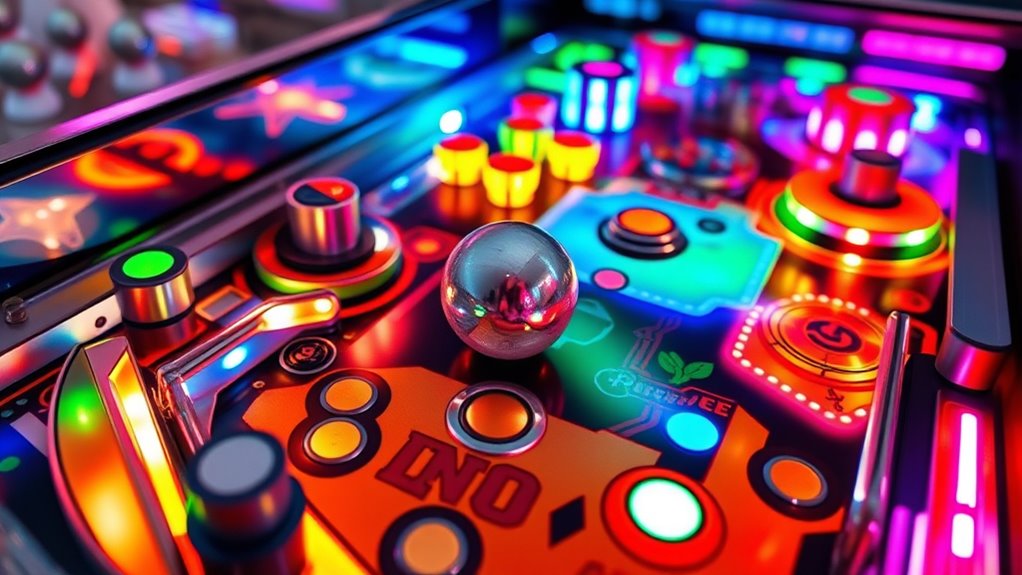
You need to guarantee that mode shifts are smooth and clear so players stay engaged without confusion. Balancing thematic variations keeps the experience fresh while maintaining coherence across modes. Designing effective player incentives motivates continued play and deepens their investment in the game. Incorporating versatility in mode design allows for a wider range of player interactions and keeps gameplay dynamic.
Clear Mode Transitions
Effective mode shifts are essential for maintaining player engagement and ensuring a smooth gameplay experience. When transitions feel seamless, they reinforce visual storytelling and uphold thematic consistency, immersing players deeper into the game’s narrative. Clear transitions can evoke excitement, anticipation, and satisfaction by signaling progress and rewarding focus. To achieve this, consider:
- Using visual cues that clearly mark the start and end of modes
- Maintaining thematic elements to reinforce immersion
- Timing transitions to match gameplay flow
- Employing sound effects to enhance clarity
- Simplifying mode changes to avoid confusion and frustration
These strategies create a cohesive experience, making players feel connected and invested. Well-designed mode transitions keep players eager to see what’s next, elevating gameplay from mere mechanics to a compelling story. Attention to detail is crucial for identifying defects that could disrupt the flow and break immersion.
Thematic Variations Balance
Striking the right balance in thematic variations across game modes keeps players engaged and prevents monotony. You want enough diversity to surprise players while maintaining aesthetic consistency so the experience feels cohesive. You need to consider aesthetic consistency to ensure smooth transitions and a unified visual experience. Too many drastic changes can confuse or alienate players; too few may bore them. To achieve this balance, consider blending subtle thematic shifts that enhance gameplay without disrupting the core theme. For example, use different visual or audio cues to reflect mode changes, maintaining overall aesthetic consistency. Use variations that complement each other and build on the core theme. Here’s a quick example:
| Mode A | Mode B |
|---|---|
| Futuristic neon | Cyberpunk city |
| Bright, energetic | Dark, mysterious |
| Upbeat soundtrack | Tense, atmospheric |
Player Incentives Design
Balancing thematic variations across game modes is vital, but equally important is designing incentives that keep players motivated and engaged. Your reward systems should tap into player motivation, making each mode feel meaningful. Effective incentives create a sense of achievement, excitement, and curiosity. Consider these aspects:
- Unexpected rewards that surprise and delight, fueling anticipation
- Progressive challenges that build confidence and mastery
- Exclusive bonuses that evoke pride and exclusivity
- Clear goals that inspire relentless pursuit of success
- Visual and audio cues that evoke excitement and immersion
- Incorporating player motivation principles from game design can significantly enhance engagement by aligning rewards with what drives players to continue playing.
Triggering and Progressing Through Modes

Understanding how to trigger and progress through different game modes is essential for maintaining player engagement. You should use clear audio cues and visual indicators to signal mode activation, making players aware they’ve entered a new phase. When a player hits specific targets or completes objectives, trigger mode changes with distinct sounds or flashing lights that grab attention. To guarantee smooth progression, design these cues to be intuitive and immediate, so players know their actions impact the game state. Use visual indicators like color changes or on-screen prompts to guide players through each stage. This combination keeps players focused, builds anticipation, and creates a rewarding sense of achievement as they move through modes seamlessly. Clear cues are key to an engaging and cohesive gameplay experience. Effective communication of mode changes helps players understand and anticipate game flow, enhancing overall enjoyment.
Designing Multiball for Excitement and Challenge

Designing multiball for excitement and challenge involves creating a scenario that captures players’ attention and tests their skills. Focus on crafting compelling multiball aesthetics that amplify the visual thrill and intensity, making each launch feel epic. Use mode customization to tailor the experience, increasing difficulty or adding unique objectives as players progress. To evoke emotion, consider these elements:
- Explosive visual effects that energize each multiball start
- Dynamic sound cues heightening anticipation
- Varied ball speeds and trajectories to keep players alert
- Unique in-game rewards tied to multiball success
- Clear, satisfying feedback that celebrates skillful play
These elements combine to make multiball not just a challenge but a memorable, exciting spectacle that keeps players engaged and enthusiastic for more.
Balancing Risk and Reward in Mode Transitions
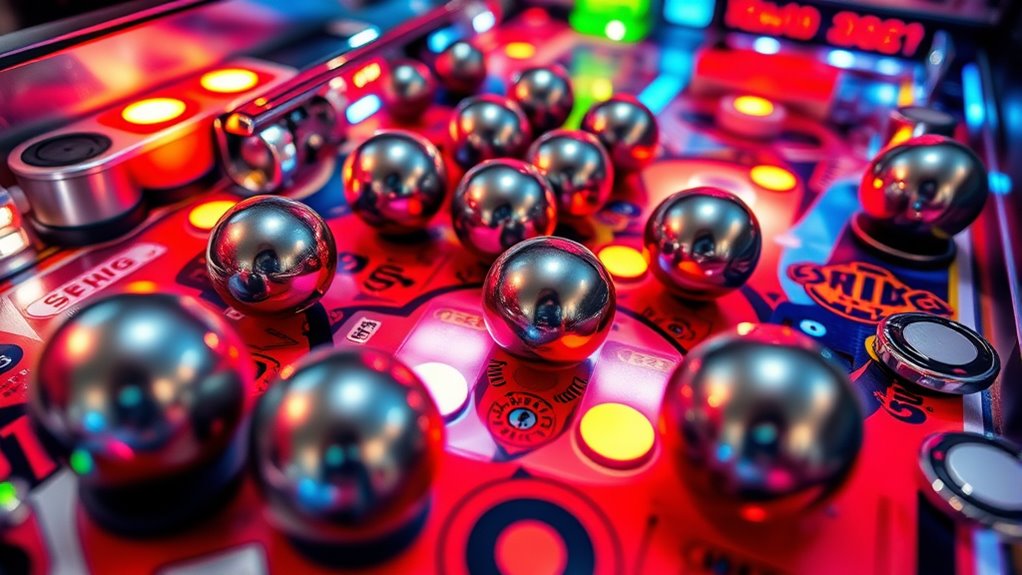
You need to time your mode changes carefully to keep players engaged without feeling overwhelmed. Clear shift cues help players anticipate risks and rewards, making the switch smoother. Remember, the consequences of taking a risk should feel meaningful, encouraging thoughtful decision-making.
Timing of Mode Changes
Timing of mode changes is crucial because it directly influences your experience of risk and reward. Proper timing synchronization guarantees transitions feel seamless, maintaining the game’s flow and excitement. If switches happen too abruptly, you may feel disoriented; if too delayed, the game drags, killing momentum. When you master transition fluidity, players stay engaged and motivated.
Consider these emotional impacts:
- Surge of adrenaline when a mode switches at just the right moment
- Frustration from poorly timed changes that interrupt your rhythm
- Elation when timing feels intuitive and rewarding
- Tension building as you anticipate the next transition
- Satisfaction from smooth, well-executed mode shifts that heighten engagement
Clear Transition Cues
Clear cues signal to players when a mode change is about to happen, helping them prepare mentally and physically for the shift. Visual cues, like flashing lights or changing colors, grab attention and indicate an upcoming shift. Sound signals, such as a distinctive tone or chime, reinforce the message and alert players even if they’re focused elsewhere. These cues create a smooth, predictable experience, reducing confusion and frustration. When players recognize the signals, they can adjust their strategies, deciding whether to risk continuing their current play or prepare for the new mode’s challenges. Well-designed transition cues balance anticipation and clarity, ensuring players feel in control and engaged. Effective visual and sound signals are essential for guiding players seamlessly through mode changes, maintaining game flow and excitement.
Consequences of Risks
Have you ever wondered how players weigh the risks and rewards when shifting between game modes? It’s all about risk management and understanding player psychology. When a mode shift offers high rewards with significant risks, players feel a rush of excitement or anxiety. These consequences can:
- Heighten adrenaline and engagement
- Create a sense of vulnerability or mastery
- Influence decision-making under pressure
- Reinforce confidence or frustration
- Drive strategic risk-taking or caution
Balancing these elements makes transitions meaningful, encouraging players to weigh their options carefully. Properly managing the consequences of risks keeps gameplay engaging and unpredictable, ensuring players stay invested. Recognizing how players perceive danger and reward shapes your design, creating a compelling experience that challenges their instincts without overwhelming them.
Combining Modes and Multiball for Strategic Depth
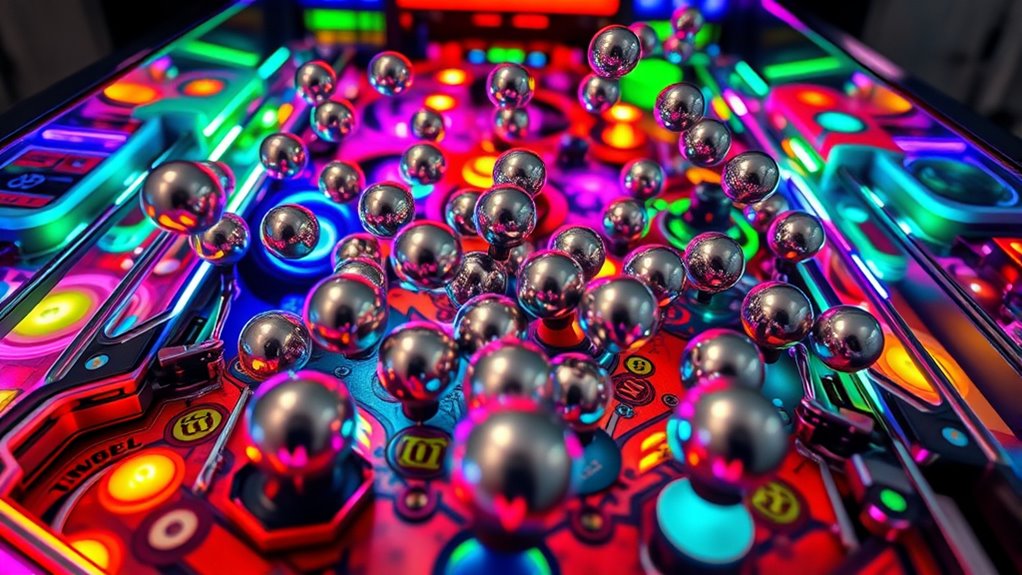
Integrating modes and multiball elevates strategic depth by encouraging you to adapt your approach and prioritize different objectives. This combination creates opportunities for dynamic scoring, as you shift focus between completing mode-specific tasks and managing multiball chaos. It also taps into player psychology, motivating you to make strategic decisions about timing and risk-taking. When you juggle modes with multiball, you must weigh the benefits of building multipliers against the dangers of losing balls. This layered gameplay pushes you to think critically about when to switch priorities, adding complexity and engagement. The interplay between modes and multiball keeps gameplay fresh, rewarding adaptability, precision, and timing—all essential for a rich, strategic pinball experience.
Visual and Audio Cues in Mode Progression

Visual and audio cues serve as essential guides during mode progression, helping you stay aware of your current objectives and upcoming shifts. Clear visual cues, like flashing lights or color changes, signal when a mode is active or about to change. Audio signals, such as sound effects or spoken prompts, reinforce these progressions and keep you engaged. Effective cues evoke strong emotions—excitement, anticipation, or urgency—making gameplay more immersive. They also reduce confusion, allowing you to focus on strategic decisions. Pay attention to:
Visual and audio cues guide your progress, evoking emotions and reducing confusion for immersive gameplay.
- Bright, flashing lights indicating mode start
- Distinctive sounds signaling mode completion
- Color shifts highlighting current objectives
- Voice cues providing real-time updates
- Subtle cues hinting at upcoming changes
These visual cues and audio signals work together, creating an intuitive, emotionally charged experience that guides you seamlessly through mode progression.
Common Pitfalls in Mode and Multiball Design
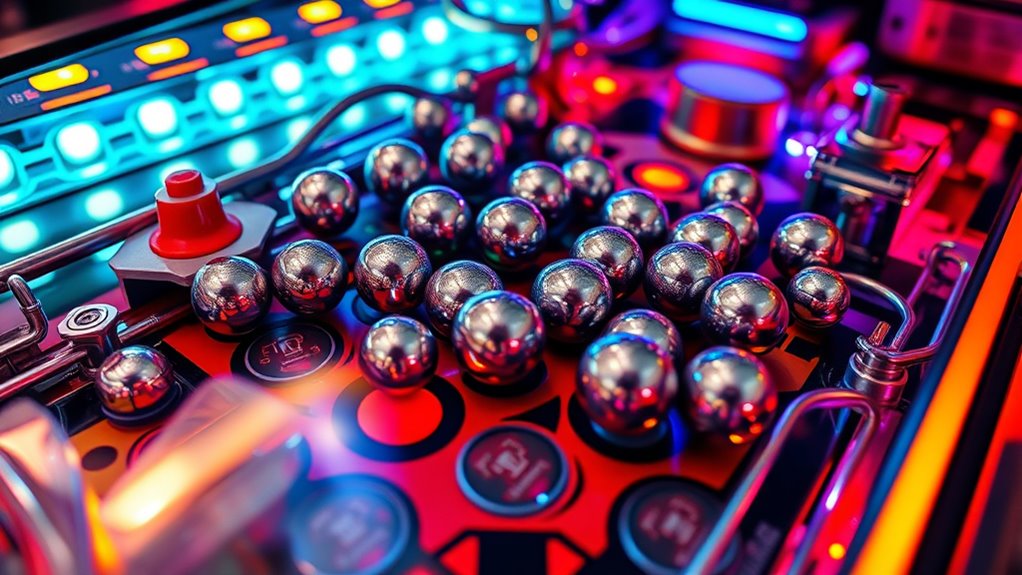
One common pitfall in mode and multiball design is creating confusion through unclear or inconsistent cues. When cues aren’t well-defined, players struggle to understand objectives, reducing engagement. To avoid this, focus on clear, cohesive creative storytelling that guides players smoothly through each mode or multiball phase. Hardware integration plays a vital role here—if switches, lights, or sounds don’t align with the narrative or gameplay, players become disoriented. Inconsistent cues can also break immersion and hinder flow. Make sure visual and audio signals complement each other and reinforce the story or objectives. By establishing consistent, intuitive cues and integrating your hardware thoughtfully, you create a seamless experience that keeps players immersed and motivated to progress.
Innovations in Modern Mode and Multiball Mechanics
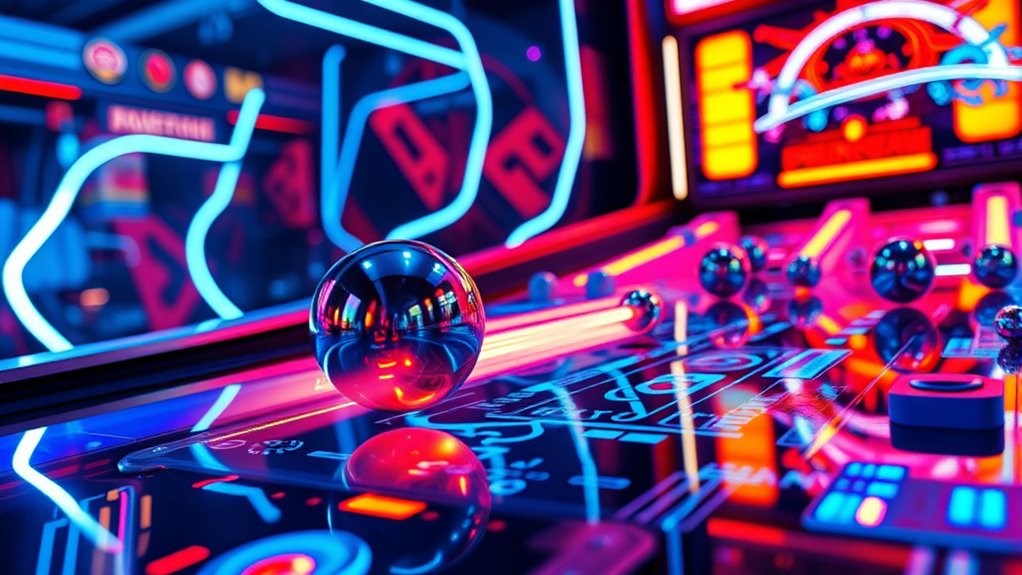
Have you noticed how modern pinball machines are pushing the boundaries of traditional mode and multiball design? Today’s innovations focus on immersive interactive storytelling and cutting-edge hardware innovations. These advancements create more dynamic, engaging experiences that captivate players. You’ll see features like multi-layered modes that respond to your choices, making each game unique. Hardware innovations, such as advanced sensors and responsive displays, allow for seamless integration of storytelling elements. Multiball mechanics now often synchronize with modes, amplifying excitement and tension. This evolution sparks emotions like thrill, anticipation, and immersion.
Modern pinball blends immersive storytelling, advanced sensors, and synchronized multiballs for a thrilling, interactive experience.
- Feel the rush as multiballs flood the playfield with purpose
- Experience storytelling that reacts to your moves
- Witness hardware that adapts in real-time
- Feel your heartbeat race during high-stakes modes
- Celebrate every mastery with innovative, rewarding mechanics
Frequently Asked Questions
How Do Modes Influence Overall Pinball Game Replayability?
Modes substantially boost your pinball game’s replayability by adding variety and excitement. They influence progression pacing, keeping you engaged as you work toward completing objectives. Reward systems within modes encourage you to master different challenges, making each game feel fresh and rewarding. By integrating modes thoughtfully, you guarantee players stay motivated to keep playing, exploring new strategies, and experiencing the game’s full depth.
What Are the Best Practices for Balancing Multiball Difficulty?
Imagine a pinball table where multiball escalation is smooth, and mode pacing strategies keep players engaged. To balance multiball difficulty, you should gradually increase the complexity and risk, ensuring players feel challenged but not frustrated. For example, start with simple multiball shots and escalate to more difficult ones. Adjust timing and shot difficulty based on player skill, creating a rewarding experience that keeps the game exciting and balanced.
How Can Visual Cues Enhance Mode Recognition and Player Immersion?
You can enhance mode recognition and immersion by incorporating clear visual cues like lighting, color changes, and animations that signal mode activation. These cues guide players intuitively, making progressions seamless and engaging. Using immersive design elements helps players feel more connected to the game environment, heightening excitement. Thoughtful visual cues prevent confusion, ensuring players focus on gameplay while feeling fully immersed in the game’s atmosphere.
What Are Innovative Approaches to Integrating Modes With Digital Displays?
You can innovate by using dynamic display integration to seamlessly showcase mode changes, making shifts visually engaging. Incorporate interactive mode transitions that respond to player actions, creating a more immersive experience. For example, use animations or lighting effects on digital displays to signal mode shifts clearly, encouraging players to stay engaged. This approach not only enhances clarity but also heightens excitement, making the game more compelling and intuitive.
How Do Designers Prevent Mode and Multiball Fatigue During Long Play Sessions?
To prevent fatigue during long play sessions, you should incorporate progressive difficulty to keep players engaged without overwhelming them. Balance challenging modes with moments of relief to avoid sensory overload, which can cause frustration. Use visual and audio cues sparingly and vary gameplay pacing, so players stay immersed without feeling exhausted. This approach guarantees sustained enjoyment and prevents burnout, keeping players excited and engaged throughout extended play.
Conclusion
Did you know that well-designed modes and multiball features can boost a pinball game’s replayability by up to 30%? By understanding how to structure these mechanics, you can create engaging, dynamic experiences that keep players coming back. Focus on clear cues, strategic challenges, and seamless integration to maximize excitement. When you master these essentials, you’ll elevate your game’s appeal and make sure players stay hooked from start to finish.


